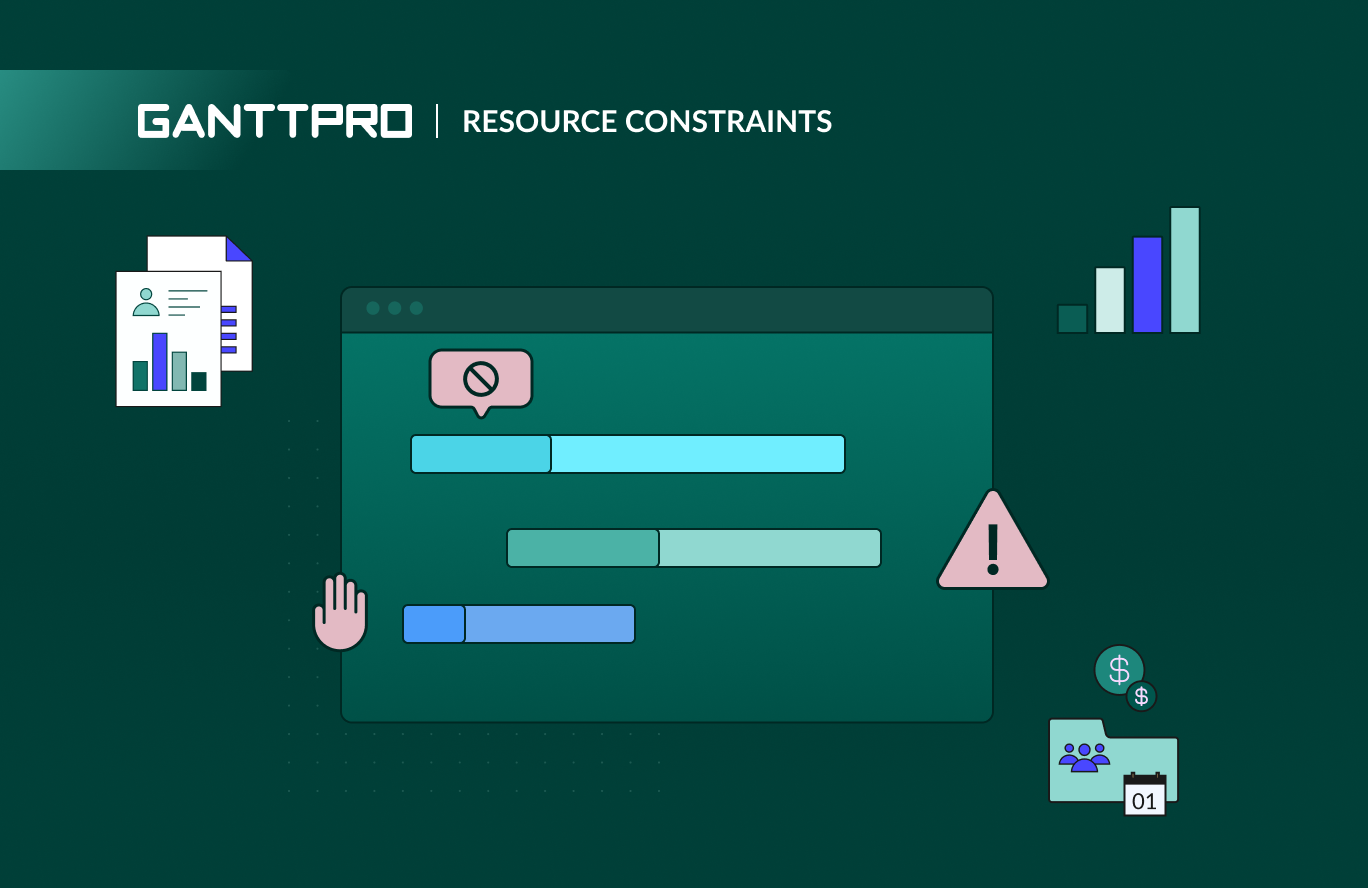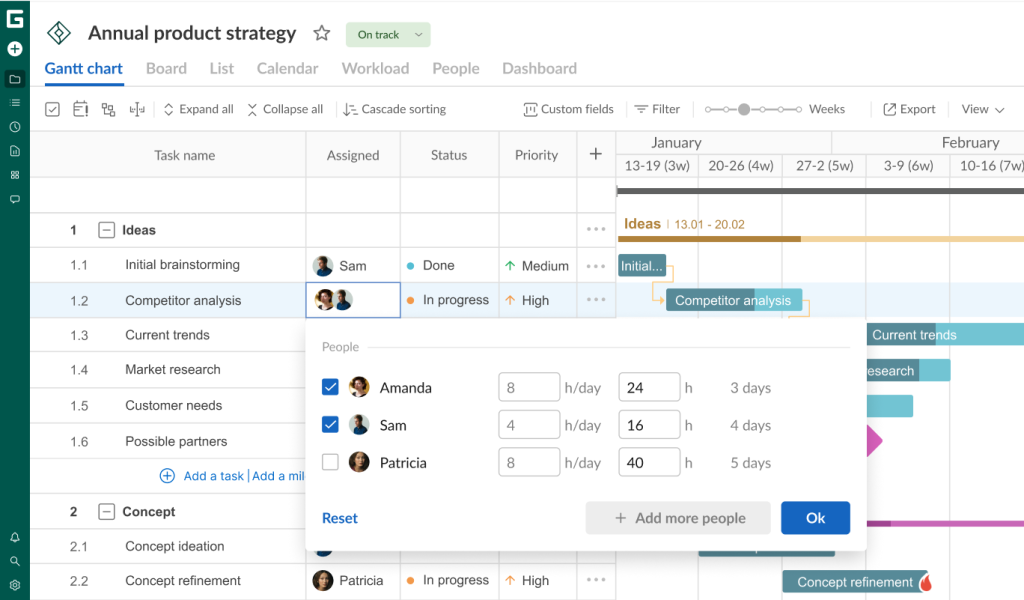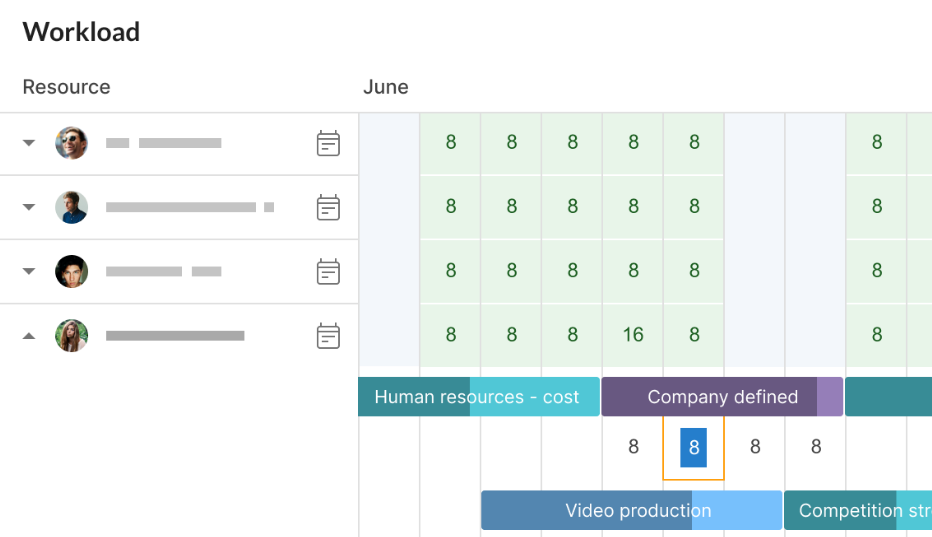How to Deal With Resource Constraints in 2026: Tips and Examples for Project Managers

Audio version:
Project managers often face the tough decision of putting promising project ideas on hold due to resource constraints.
These constraints are a common challenge across various industries. They can frustrate and demotivate any project team even if they have a well-prepared resource management plan. After all, big professional ambitions and green lights from stakeholders won’t help if you have problems with project management resources.
What types of resource constraints disrupt the harmony of project processes? How to handle them using simple yet powerful recommendations?
This article will help you understand the resource constraints meaning and find ways to deal with these issues.
Contains:
- What are resource constraints in project management?
- Types of resource constraints.
- How to manage resource constraints.
What are resource constraints in project management?
Resource constraints in project management refer to the limitations on the availability, utilization, and allocation of resources necessary to execute a certain project.
Your project may experience constraints due to limited asset availability, budgetary restrictions, competing projects, personnel skill sets, and more. Such constraints often require careful planning, detailed prioritization, and optimization to ensure effective project completion within the defined scope and objectives.
By the way, insufficient resources are the fourth most popular reason for project failure (52%), according to research and survey data (2023).
If you wonder how to allocate resources smoothly without harmful obstacles in operating work assets, you should understand the main constraints, distinguish them from each other, and be able to balance them if there are many restrictions in a single project.
Most common types of resource constraints
There are various types of resource constraints encountered in project planning. They can be classified into primary categories, where each limitation affects the execution of the entire project in different ways.
When experienced PM specialists hear about typical resource constraints, they usually recall the concept of the Project Management Triangle (you may also come across names like Iron Triangle or Triple Constraint). This model describes the constraints of project management in general, defining three main elements:
- Cost refers to budgetary constraints within projects.
- Time, or schedule, denotes a project timeline, encompassing deadlines for the project’s overall completion or its certain stages.
- Scope outlines the objectives, tasks, and milestones necessary for project completion.
The triangle demonstrates relationships between these constraints. When one side is changed, it affects the other two sides. For example, if the scope of a project is expanded (extra features are added), it will likely require more time or extra finances to complete.
Below we describe these three types of resource constraints in project management but also complement them with other equally important limitations and restrictions related specifically to resources.
So let’s take a look at each of the resource constraints in project management and explore the ways to manage them correctly.
1. Time constraints

Time is a vital resource for most projects in any sphere, including marketing, IT, construction, education, and other sectors.
Time constraints limit the period available for completing a project or specific tasks. They are essential because time, unlike other resources, cannot be recovered or extended.
The duration assigned to a project can affect the quality of the final result, from the initial planning stage to its completion. Thus, it’s crucial to use professional resource management tools to track the time dedicated to project tasks. This approach helps manage time limitations effectively and ensures the project is completed successfully.
Software that offers a resource calendar is beneficial for distributing and coordinating teams and resources efficiently. It enables meeting deadlines while maintaining the quality of work.
To manage this type of constraint, you should create a schedule where you will break your project into smaller tasks and allocate completion time to each activity, making adjustments if needed.
Time resource constraints example
Let’s consider one of the project resource constraints examples in the healthcare industry.
A chief medical officer of a hospital and a project manager face the task of creating and implementing a new online patient registration system within a strictly established time frame. This project must be implemented and tested in a month. However, the main developer-contractor unexpectedly fell ill, and the only deputy is currently on vacation.
The lack of developers should not confuse the executives and harm the project because it is possible to organize and prioritize tasks using a work breakdown structure (WBS), keep an accurate log of hours worked, and replace the current tasks of the deputy developer with the actual activities immediately after his return from vacation.
2. Budget constraints

Project finances are often considered the most important determinant of project success as they affect every stage of resource planning. The established budget usually defines the availability, capacity, and allocation of other resources.
Bent Flyvbjerg, one of the authors of the book “How Big Things Get Done” (2023) found that 91.5% of projects go over budget, over schedule, or both. It often happens due to obvious and hidden problems with the project finances.
Financial limitations are what define budget constraints within a project, dictating the available funds for resources. These constraints influence procurement, staffing, and the project’s overall scope.
Responsible managers must engage their knowledge and skills as well as apply powerful resource allocation methods and strategic techniques to organize budgets, control expenses, and utilize all financial assets efficiently.
Budget resource constraints example
To better grasp the examples of resource constraints in project management, let’s consider a real-world scenario within the marketing field.
A creative agency needs to organize a one-day exhibition within a global sports event on a limited budget. A marketing manager may outsource some activities to volunteers and involve some low-cost or free resources.
The manager finds a solution to involve the employees and some clients of the gym where the exhibition is planned as volunteers. In addition, it is decided to try a free trial of a reliable project management tool with cost management functionality. It helps schedule the event, track expenses, and guarantee that the project stays within the budget.
3. Scope constraints

The scope is a crucial factor for planning resources needed for a project. It outlines the main objectives, expected outputs, functionalities, and the tasks necessary for project finalization. Understanding the scope enables teams to organize resources efficiently and ensure the quality of the outcome is not affected.
Furthermore, the scope encompasses the complexity of tasks and the level of expertise required to meet project needs. This factor helps identify the point at which it becomes essential to seek external resources for certain tasks or consider the recruitment of new team members.
Scope constraints typically refer to the limitations or boundaries set on the scope of a project. It’s important for managers to anticipate these constraints, including the potential for scope creep at various stages of their projects, and to take proactive measures to avoid it. Possible strategies may include creating a comprehensive project plan and securing approval from all stakeholders before moving forward with production.
Scope constraints example
One of the vivid examples of resource constraints related to project scope can be found in the construction sphere.
Imagine a building project where the scope is clearly defined. It includes the construction of a five-story hotel building with specified dimensions, materials, and design features.
During the construction phase, the project encounters a scope constraint when it is found that it doesn’t include additional structures like landscaping services or underground parking. This factor leads to a delay in construction activities, as new works and processes need to be sourced and approved.
A project manager recognizes the necessity of dedicating resources like budget, workforce, and materials exclusively to finalizing the specified construction within the set timeframe.
4. Human resource constraints

Efficient workforce management is also vital for project success. Insufficient staffing for project tasks can lead to delayed progress and potential failure.
Frequently, constraints in human resources can imply a limited availability of individuals possessing the necessary skills and experience. This situation may arise from challenges in both attracting and keeping proficient staff.
Gabriel Smith, the VP of Innovation at Pricefx, the pricing software, shares his thoughts:
Resource planning is a lot easier if you hire self-motivated people with a learning and growth mindset who have shown the willingness and ability to challenge themselves and wear multiple hats in the past. Experience is important for the core role you are hiring for, but talent, mindset, and a willingness to operate outside of one’s comfort zone are key attributes for success.
Human resources constraints example
The lack of high-skilled IT professionals is a common situation in the software development sphere. As an example, consider a software development company that is tasked with developing an e-commerce website for a client within two months. However, all experienced developers are already involved in existing projects that can not be moved.
A project manager realizes a shortage of skilled specialists and decides to attract two freelancing developers who already have enough experience in working with the company. There’s no need to spend time on hiring and the PM can seamlessly prioritize tasks across the team and attract side developers.
5. Equipment and tool constraints

This constraint involves restricted access to essential tools like machinery, vehicles, hardware, software, or any other necessary assets required for a specific project. It can be a lack of physical assets or outdated technology that may obstruct efficient work processes.
The limitation in tools and equipment availability can profoundly affect the outcome of a project. Therefore, it’s crucial for project managers to adeptly address these challenges, guaranteeing that projects are finalized within the allocated time and budget.
Equipment and tool constraints example
In the manufacturing industry, equipment and tool resource constraints refer to limitations in the availability, capacity, or functionality of machinery and technical tools required for production.
Consider a factory that produces automotive parts. A constraint can be related to the limited number of computer numerical control machines. They are essential for precision manufacturing, but their high cost and space requirements might limit the factory to only a few units.
This constraint impacts the production rate, as only a certain number of parts can be machined at any given time. Moreover, these machines require specific maintenance, so their availability and the time taken for maintenance can further limit production capacity.
6. Material and supply constraints

Another type of challenge in project asset management refers to materials and supply chains. They usually refer to the limited availability of necessary assets and supplies because of chain disruptions or increased demand for specific materials.
Project managers should care about materials and supply systems during the initial stage of project planning because these types of constraints can also be a reason for unexpected challenges and project delays.
Material and supply constraints example
There can be different examples of resource constraints in project management related to material usage and supply. Let’s consider a case from the marketing sphere.
Imagine a technology company planning a global marketing campaign to promote a new smartphone.
The company wants to distribute new-wave wireless earbuds as a promotional item. However, the supply of these earbuds is constrained due to a global shortage of microchips. A project manager understands that this shortage may significantly impact the project’s timeline and budget. Perhaps, the company will need to find alternative suppliers at a higher cost or delay the campaign until the earbuds are available.
7. Legal and regulatory constraints

These types of constraints include different legal and regulatory requirements that a project must comply with. They may refer to industry-specific regulations, environmental laws, safety standards, and other legal obligations. Compliance with these constraints is critical but can also limit flexibility in project execution.
Legal and regulatory constraints can be the reason for additional costs. They may require specialized expertise and impact project time frames.
However, True Tamplin, the founder of Finance Strategists, the financial education organization, has found the pluses in these constraints:
While these constraints can present challenges for businesses, they also drive the development of safer, more sustainable, and innovative products and services. By staying informed, engaging with regulators, implementing strong compliance programs, and collaborating with industry peers, businesses can successfully navigate the complex landscape of regulatory constraints and contribute to a better future for all stakeholders.
Legal and regulatory constraints example
Thinking of related resource constraints examples, we decided to turn to the healthcare field.
Imagine a pharmaceutical research project, where strict regulatory constraints dictate the whole clinical trial process.
Each trial phase must comply with certain regulatory standards. A project manager may not always know what legal documents and justifications may be needed at a particular phase. It can significantly prolong a project timeline.
8. Environmental constraints

Environmental constraints mean limitations or restrictions on resource usage that arise due to environmental considerations. These constraints are essential for ensuring sustainable asset management and minimizing negative impacts on ecosystems and human health.
Environmental constraints are usually imposed through special policies, regulations, and laws that aim to reduce pollution, protect natural habitats, and conserve resources for future generations. They often involve balancing economic and developmental goals with environmental protection.
Environmental constraints example
Let’s consider a company involved in the sphere of forestry within the timber industry, where environmental constraints play a crucial role.
To manage a project in the timber industry sustainably, it’s required to consider environmental constraints such as limits on the amount of timber, restrictions on logging in certain areas to protect biodiversity, and so on.
The company can also be required to adhere to standards that ensure the protection of water resources and wildlife habitats.
9. Cultural and social constraints

When project teams face social and cultural constraints, they define the limitations and challenges arising from the social values, norms, and practices.
These constraints often dictate how resources are perceived, valued, and utilized. In many cases, these factors can lead to conflicts of interest, especially when modern management practices meet traditional approaches.
Understanding these constraints can be critical for effective resource management, and their ignoring can lead to resistance, mismanagement, and ultimately, the failure of projects.
Cultural and social constraints example
Consider a water management project in a town, located in a culturally rich and diverse region. Its goal is to generate an advanced water purification and distribution system to improve the town’s water quality and availability.
However, a project manager doesn’t take into account the deep-rooted cultural beliefs among citizens living in the river surroundings. They insist that the river is considered sacred, and any interference with its natural state is viewed as disrespectful to their traditions.
The situation leads to widespread protests. A project team realizes its oversight, halts the construction, and initiates a series of community engagement sessions. All this results in a project delay.
Now that you know the main types of asset limitations and the consequences that can occur because of resource constraints, it’s the right time to move on to certain ways to manage them.
How to manage resource constraints
If resource constraints are inevitable, you will have no other choice but to look for the light at the end of the tunnel and optimize the situation.
How to deal with resource limitations effectively without risking your project’s health?
Here are some recommendations on how to manage resource constraints like a pro.
- Correctly define your project scope.
- Know constraints by sight.
- Take the choice of resource management software seriously.
- Visualize and allocate resources responsibly.
- Plan a better perspective for what’s ahead.
- Distribute workloads effectively.
- Prevent risks.
- Encourage flexibility.
1. Correctly define your project scope
Identifying a project scope involves establishing clear boundaries for a project. A clear understanding of this scope helps identify what is in and what is out, as well as facilitate optimal resource allocation in project management. It acts as a protective barrier, guarding against irrelevant tasks and preserving resources.
To define project scope, you have to know your project goals and objectives, predict desired outcomes, and establish criteria for their success. You should also use a professional WBS creator to deconstruct the overall scope into smaller segments. Additionally, you should align it with stakeholders, assess their expectations, and mitigate the risk of scope expansion later.
2. Know constraints by sight
It’s important to consider all potential constraints in detail even before they arise. Without understanding your resource-related issues, you won’t be able to manage them effectively. It may seem trivial, but it’s better to be theoretically prepared for problems than not to know how to behave at a crucial moment.
Once you know your project constraints, you can assess what risks you might face and what assets you’ll need.
3. Take the choice of resource management software seriously
Even though project management software is quite popular worldwide, only 25% of companies use it to effectively manage their work. The remaining 75% still depend on multiple tools, spreadsheets, etc.
Professional resource management functionality is also often ignored by executives. However, this functionality appears to be very useful in many cases, as it can be really difficult to determine who in your project needs to do what and when.
This is where smart resource scheduling tools come in handy.
A powerful online solution assists project teams in allocating resources based on priorities and general project requirements. It also helps implement resource management techniques.
One of the reliable platforms for planning and managing resources is GanttPRO.

The software is highly demanded because of its online Gantt chart with resource allocation.
The chart serves as a handy visualization system that lets managers schedule, organize, assign, and control resources with ease. It allows GanttPRO to deservedly be considered one of the best Gantt software with wide resource management capabilities.
PM professionals choose the tool because it helps them achieve excellence in project management, task scheduling, activity tracking, deadline control, collaboration, and advanced resource planning for multiple projects.
Project teams rely on GanttPRO for project planning, task organization, and effective resource allocation, acknowledging it as robust resource management software.
In GanttPRO, you can easily divide your project into manageable tasks and subtasks as well as specify deadlines for them. Handy drag-and-drop will help you visualize required dependencies between tasks and place milestones on a Gantt chart.
4. Visualize and allocate resources responsibly
Project teams prefer to visualize and store their project management resources in one easily managed location.
When all tasks are placed on a Gantt chart, GanttPRO allows for inviting teammates and specifying their roles, as well as setting costs and calendars for them. You are also allowed to place virtual resources here (people, materials, equipment, tools, etc).
This is what Ben Emmons, the director of special projects at MagMod, a company that produces flash modification systems, values in GanttPRO:
Adding team members is great but sometimes you want to run through some what-if scenarios without using up your plan quota. GanttPRO gives you unlimited virtual resources that are great for planning purposes.
After that, it’s easy to assign team members or resources to your certain activities.
In GanttPRO, you can allocate one or several assets to each task.

5. Plan a better perspective for what’s ahead
Having chosen such a reliable tool as GanttPRO and keeping in mind all the listed limitations that may happen to your resources during the project life cycle, you can move forward and plan a better perspective for what’s ahead.
With a well-created project plan, you’ll be ready to mitigate constraints and balance all possible asset limitations when they arise.
For example, GanttPRO will assist you in time tracking and cost estimation.
- You’ll be able to track time, allowing teammates to log their working hours on certain activities. This information will help evaluate project progress and resource performance.
- You’ll manage finances with ease. GanttPRO allows for scheduling budgets and monitoring expenses in real time, staying within cost constraints. You may set costs for all project assets per hour, per item, or just cost.

Professional resource management software
Complete projects on time, manage workload, and communicate with a team.
Sign up for free6. Distribute workloads effectively
When people are given excessive amounts of work that they cannot do effectively, they quickly become stressed and overworked. It often results in decreased productivity and morale, potentially causing missed deadlines, reduced performance quality, and weak workload management.
Using GanttPRO, you’ll get a clear visualization of workloads that will allow for advanced resource scheduling. Being recognized among the reliable workload management tools, it will simplify task tracking, enable timely resource allocation adjustments, and minimize possible constraints.

As a GanttPRO user, you’ll find the workload of your project participants right under a timeline. It’s possible to manage resources in a separate window for one project or the same window but for all projects.
Łukasz Wielądek, a project manager at GonnaBe, an advertising agency, appreciates this feature:
When I have to plan work for a team for the whole week, it’s really easy with GanttPRO. Resource workload is a nice feature because you can see how many hours a person has and adjust the workload to these hours.
7. Prevent risks
You should find and apply available risk evaluation techniques to pinpoint, evaluate, and strategize against potential threats to your project.
By establishing a comprehensive risk management strategy, you can shield your project from significant dangers and be well-prepared for any unforeseen challenges that may arise.
8. Encourage flexibility
Flexibility and adaptability are crucial for maintaining the delicate balance of project limitations.
Sometimes you will need to compromise on project elements to stay within the defined scope. A lack of flexibility may lead to a decline in the overall quality of your project.
Ensuring the satisfaction of your customers or stakeholders should be of paramount importance. It will indicate the significance of making the necessary compromises.
Tackle resource constraints strategically
Handling various types of constraints can be a challenge for project managers in their efforts to allocate and control resources effectively. However, by identifying these constraints and understanding the reasons why they arise, you can be better prepared to mitigate and communicate them to clients and stakeholders properly.
Take advantage of professional resource management software like GanttPRO to curb various constraints in your project management environment and boost your work success.
Frequently asked questions about resource constraints
-
Typical resource constraints refer to limitations in the availability of resources necessary for the successful completion of a certain project. Common examples include constraints related to time, budget, human resources, materials, technology and tools, physical space, information and data, etc.
-
Resource constraints in project management are often caused by several key factors including limited budget, time constraints, lack of human resources, physical resources availability, change in a project scope, resource allocation conflicts, technological constraints, and many external factors.
Read also
Join 1M+ project managers!
Create Gantt charts in minutes with GanttPRO and reduce time spent on managing tasks by 40%
Try for freeNo credit cards required. No obligation.


